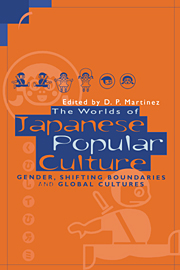Chapter 8 - Media Stories of Bliss and Mixed Blessings
Published online by Cambridge University Press: 22 September 2009
Summary
Introduction
Mutually feeding off each other and into each other, television and the popular press in post-war Japan have been the major agents for the cultural production of popular idols for mass consumption. In the corpus of dramas that are continuously being diffused through the mass media of modern Japanese society, these idols – somewhat like gods in polytheistic mythologies – while transcending ordinary existence also grow out of it and sustain that existence. While the production of these idols by the mass media mirrors a distorted version of social reality, it also plays a key role in creating new social realities.
Thus during the months of December 1992 and January 1993, the mass media in Japan became quasi-obsessed with the love stories of two young couples who suddenly rose to outshine all others in the glittering sky of Japanese celebrities. These were the stories of two “princes” and their “Cinderellas” who, as if by magic, had materialized out of a million possible candidates to become future “princesses”. In this chapter, I argue that this pair of media fairytales contain none other than variations on the same classical theme appearing and re-appearing in multiple forms throughout the cultural history of Japan. This theme concerns the art of mastering the “outside” (Origuchi 1965; Yoshida 1981; Komatsu 1985, 1989).
As tradition would have it in Japanese culture, “meditating the blessings and warding off the curses” of the world beyond the local horizon was invariably a male prerogative (Stefánsson 1994).
- Type
- Chapter
- Information
- The Worlds of Japanese Popular CultureGender, Shifting Boundaries and Global Cultures, pp. 155 - 166Publisher: Cambridge University PressPrint publication year: 1998

